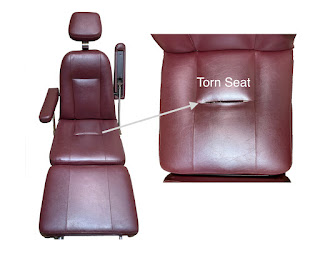 |
| Buffet Before Refinishing |
This antique buffet had been stored in someone’s garage for many years before we got it. My customer had gotten it from one of her students (she’s a music teacher) in exchange for music lessons. Who knows how long it had been stored in a garage, but it was evident it had taken on some deterioration as a result of being stored outdoors.
 |
| Buffet After Refinishing |
The top veneer was in bad shape, some of it peeling up. We were unable to remove it, so we stripped and sanded it prior to adding stain and polyurethane (3 layers) to protect it from further deterioration.
Portions of the decorative wood pieces had broken off such as the second drawer front center which is a continuation of the design on the top drawer. The far left spindle was also broken off. Luckily they had the piece and Jim was able to reattach it, but there was still another section of this piece missing completely which he had to create and make it fit in the open space. It’s difficult to create a piece that is missing entirely because you can’t measure it against anything.
The first step in the restoration process requires removing all the hardware, drawers, doors and pieces that are easily taken off the piece, such as the top. By removing these sections, it’s easier to work on them as you can reach more areas to strip, sand and stain before re-assembling it. Jim removed the decorative center on the back top as well as the top which he sanded separately, then reattached when completed. He had to create the missing spindle and glue those pieces back into place. The broken drawer sections were re-glued back on.
This buffet had a “hidden” secret drawer which was the third and bottom drawer that forms the bottom decorative edge. Jim replaced the bottom portion of that drawer because it had a felt lined bottom that was difficult to open and close so he removed and replace it. It was common to store silverware in these drawers and they were frequently lined with felt which is a deterrent for discoloration of silver. The last step for any project such as this one is cleaning and polishing the hardware. This adds that special final touch that really completes the restoration process.






